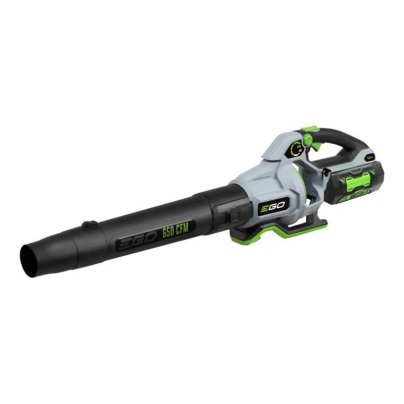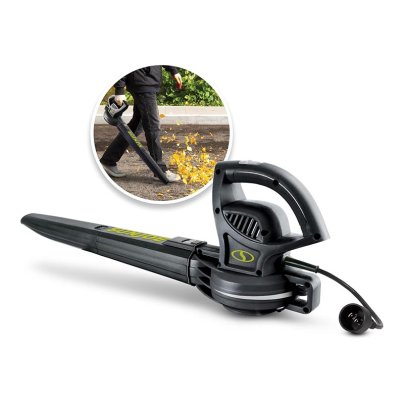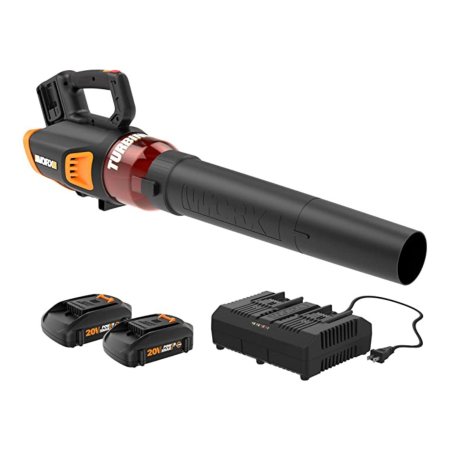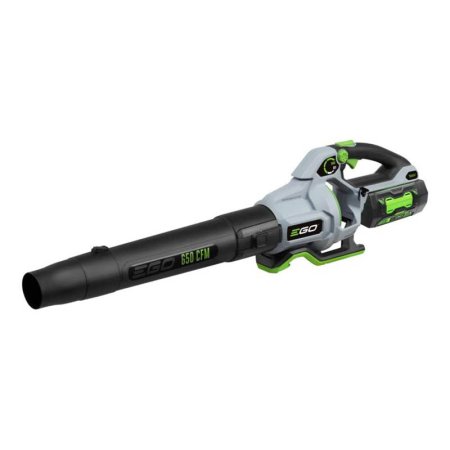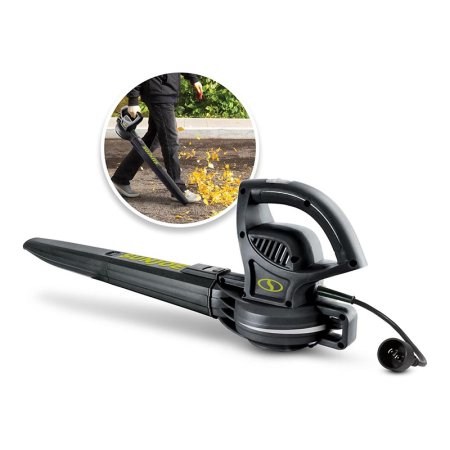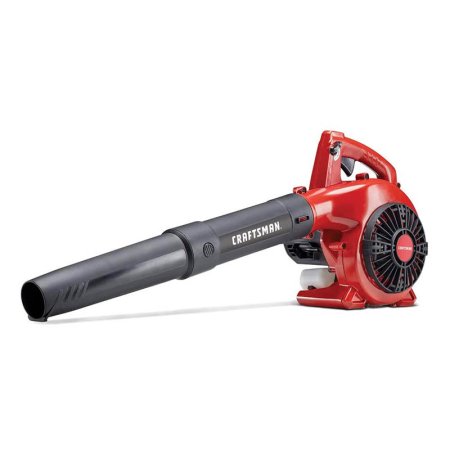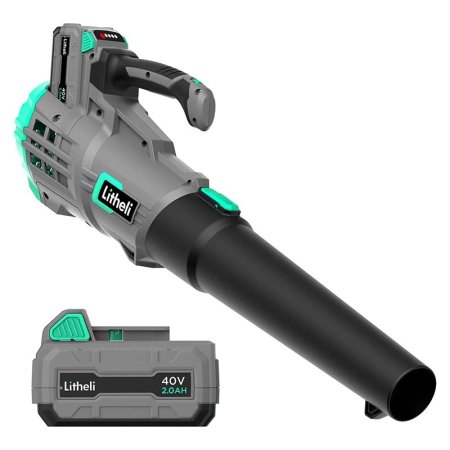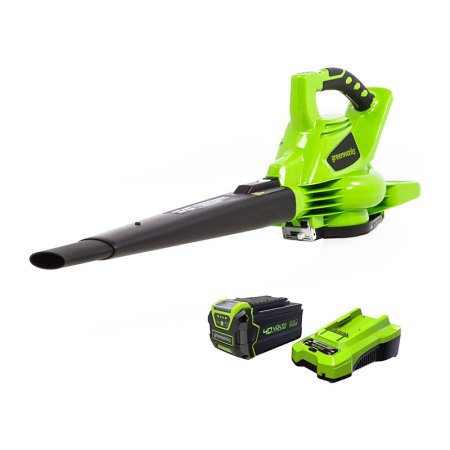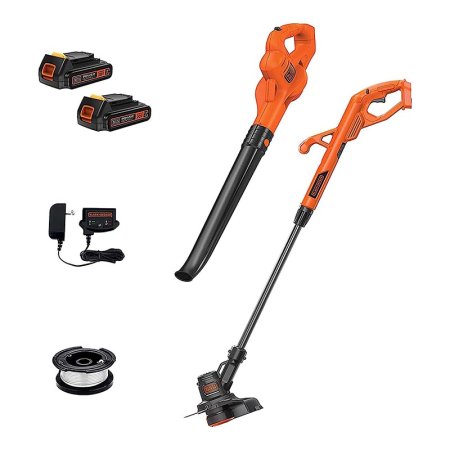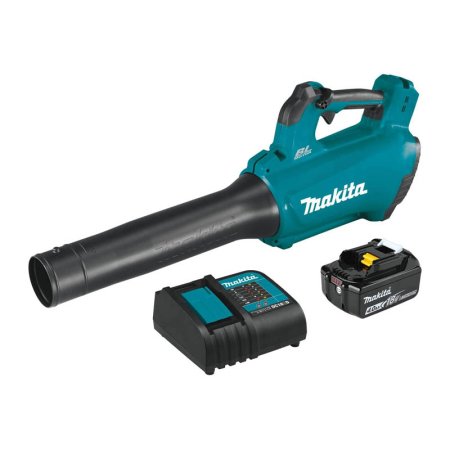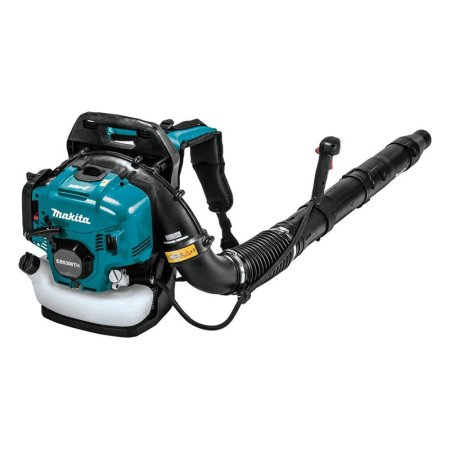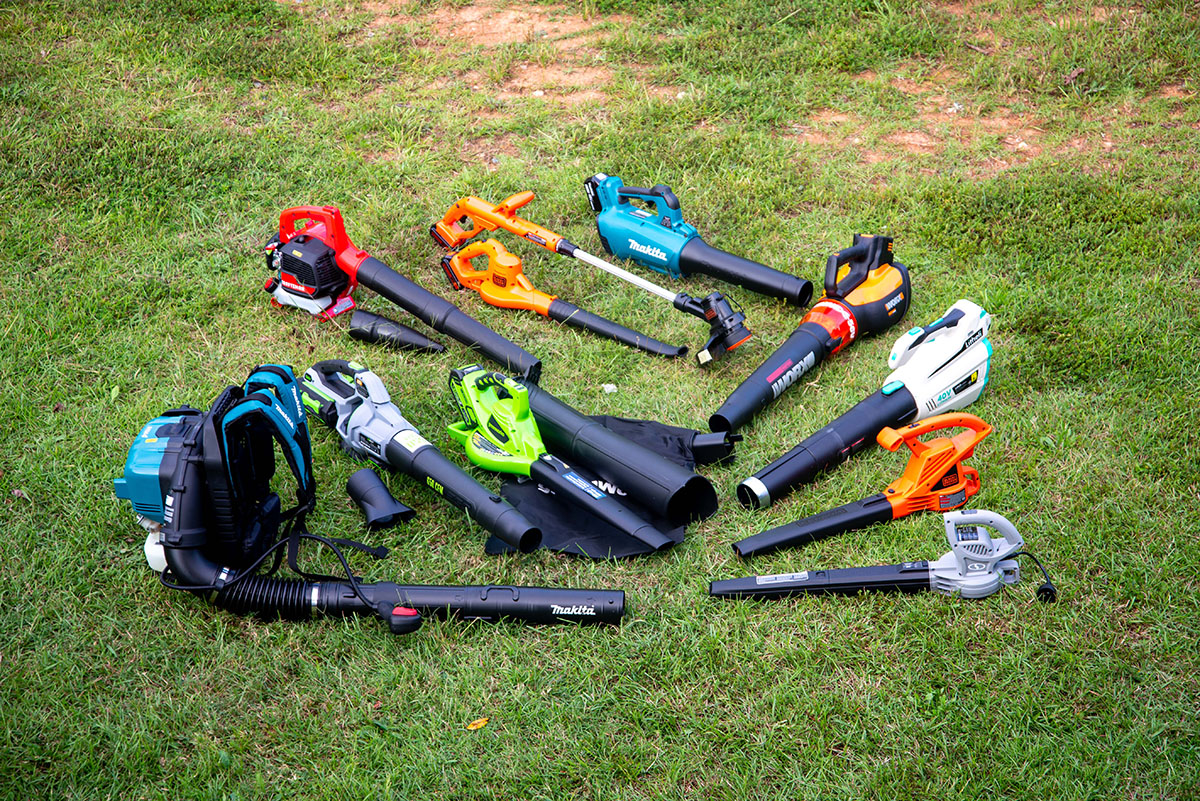
We may earn revenue from the products available on this page and participate in affiliate programs. Learn More ›
Manually raking leaves is often a laborious chore, but you can make it an easier and faster process by using a leaf blower. How much easier, you may ask? We field-tested 10 highly rated leaf blowers ranging from light-duty handheld blowers to heavyweight professional-grade models to see how well they clear leaves and debris. Check out the best leaf blowers below and find the one that will work best for your needs.
- BEST OVERALL: Worx 40V Power Share Turbine Cordless Leaf Blower
↓ Jump to Review - RUNNER-UP: Ego Power+ LB6504 650 CFM Variable-Speed Leaf Blower
↓ Jump to Review - BEST BANG FOR THE BUCK: Sun Joe SBJ597E-SJB All-Purpose Electric Blower
↓ Jump to Review - BEST LIGHTWEIGHT: Black+Decker Electric Leaf Blower
↓ Jump to Review - BEST GAS-POWERED: Craftsman 25cc 2-Cycle Gas Leaf Blower
↓ Jump to Review - BEST ADJUSTABLE SPEED: Litheli 40V Cordless Leaf Blower
↓ Jump to Review - BEST WITH MULCHER: Greenworks 40V Brushless Blower/Leaf Vacuum
↓ Jump to Review - BEST WITH TRIMMER: Black+Decker 20V MAX Powerconnect String Trimmer
↓ Jump to Review - QUIETEST OPERATION: Makita 18V LXT Lithium-Ion Brushless Cordless Blower
↓ Jump to Review - BEST BACKPACK: Makita 4-Stroke Engine Tube Throttle Backpack Blower
↓ Jump to Review
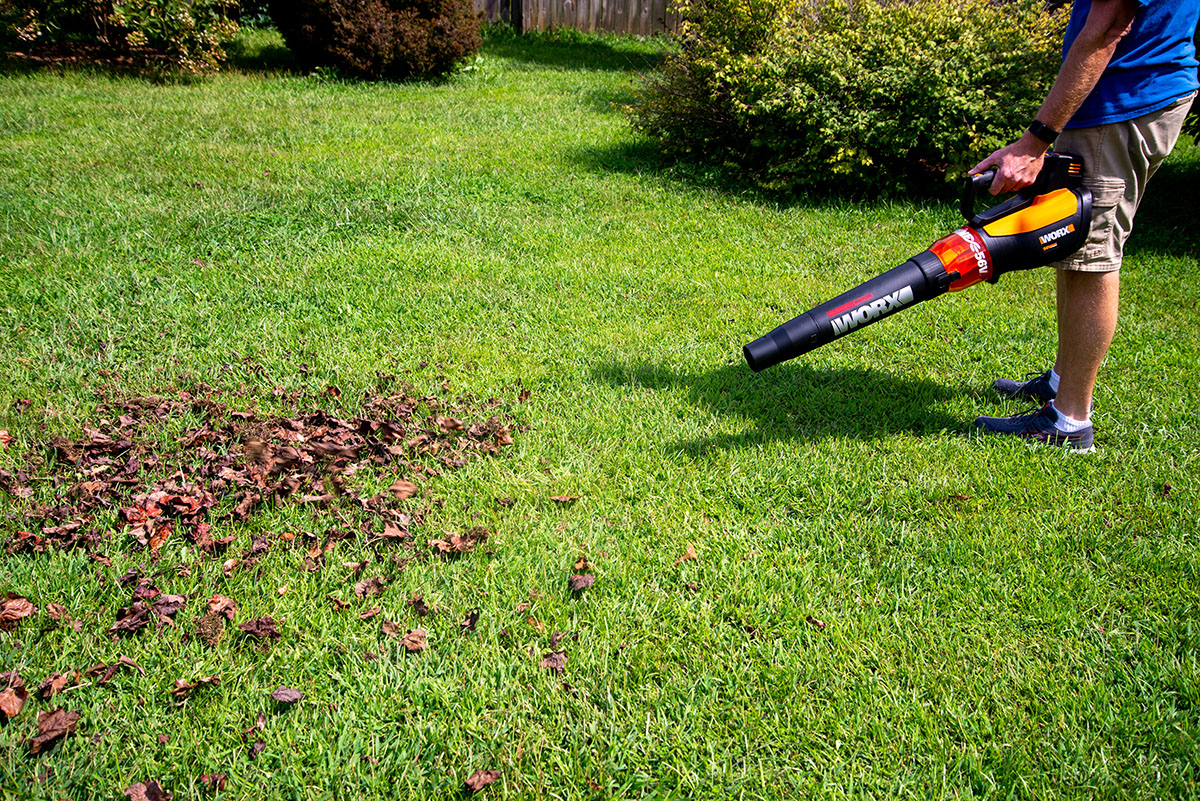
| Testing Stats | |
|---|---|
| Products tested | 10 |
| Time spent testing | 10 hours |
| Tests performed | 4 to 5 |
| Price range | $25 to $450 |
Our Top Picks
Best Overall
Worx 40V Power Share Turbine Cordless Leaf Blower
What We Like
- Impressive motor; high airspeeds and airflow volumes
- Offers variable speeds
- Cordless and lightweight
- Allows for single-handed control
What We Don’t Like
- Battery runtime varies based on speeds selected
Product Specs
- Power source: 40-volt (V) rechargeable battery
- Weight: 7.3 pounds
- Cubic feet per minute (CFM) rating: 430
This Bob Vila Approved product carries our brand’s highest level of recommendation.

Bob Vila Approved recognizes the household and DIY products that impressed us most in our real-world testing and that exemplify core values of the Bob Vila brand, including craftsmanship, innovation, and value for the dollar. Winners of this designation come recommended by our professional review team and are personally approved by Bob Vila.
Our Ratings: Ease of Use 5/5; Performance 5/5; Noise 4.5/5; Value 4.5/5
The Worx 40V Power Share turbine cordless leaf blower has an impressive motor that provides power to the turbine to generate airspeeds up to 90 miles per hour (mph) and airflow volumes up to 430 CFM. This rechargeable lawn blower actually boasts variable speeds—you can go fast and heavy, slow and light, or somewhere in between, depending on your needs and the task at hand. The Worx blower weighs only 7.3 pounds and is made to allow one-handed control.
Get the Worx leaf blower at Amazon or Lowe’s.
Runner-Up
Ego Power+ LB6504 650 CFM Variable-Speed Leaf Blower
What We Like
- Extended runtime of up to 90 minutes per charge
- Impressive power at 650 CFM
- Elongated design provides longer reach for users
What We Don’t Like
- Heavy; not ideal for extended use
- Need 2 hands to operate cruise control
- Loud charger fan not great in busy neighborhoods
Product Specs
- Power source: 56V rechargeable battery
- Weight: 10.2 pounds
- CFM rating: 650
Our Ratings: Ease of Use 4.3/5; Performance 4.5/5; Noise 4/5; Value 3.5/5
Make quick work of yard cleanup with the Ego Power+ 56-volt cordless leaf blower. It is easily controlled with a variable-speed trigger, cruise-control dial, and turbo button to move up to 650 CFM of air. We found in our tests that the longer than average body and blow tube reached farther under shrubs than the others, with ample power to clean out built-up debris and matted leaves. This was the most powerful leaf blower we tested but also the heaviest at 10.2 pounds. Most of the extra weight is in the huge battery that also gave this blower the longest runtime.
We liked that this blower moved more air with the press of the turbo button but wondered why not simply boost the top-end power at the trigger. Also, the battery weighs a lot more than the others, making us wonder if it really makes sense to add more weight just to carry it longer. This blower offered the strongest air-handling ability of all the battery leaf blowers we tested.
Read our full review: Ego Power+ LB6504 650 CFM Variable-Speed Leaf Blower
Get the Ego Power+ leaf blower at Amazon or Lowe’s.
Best Bang for the Buck
Sun Joe SBJ597E-SJB All-Purpose Electric Blower
What We Like
- Compact size is great for storage
- Pigtail electric cord for a more secure connection
- Lightweight and easy to maneuver
- Good high-power leaf blower at an affordable price point
What We Don’t Like
- No speed control
- Not great for wet leaves or those in tall grass
- Corded power source means limited range
Product Specs
- Power source: Corded electric
- Weight: 3.9 pounds
- CFM rating: 260
Our Ratings: Ease of Use 4.3/5; Performance 4/5; Noise 4/5; Value 4.5/5
The Sun Joe electric leaf blower offers an impressive airspeed of up to 155 mph to effectively remove leaves and small twigs from driveways and walks. In our tests, it performed as well as bigger, more powerful blowers on hard surfaces, although not quite as fast, and it lagged somewhat in grassy areas. Weighing in at just 3.9 pounds, the single-speed blower is easy to hold with just one hand.
The Sun Joe features a 6-amp electric motor with a short “pigtail” cord that should be connected to either a 16-gauge 50-foot exterior cord or a 14-gauge 100-foot extension cord for safe outdoor operation. The short cord makes it easy to tie off the plug for a secure connection that won’t easily separate.
A standout for power at a low price, the Sun Joe is great for clearing away grass clippings and light leaf accumulation in garden areas, sidewalks, and garages.
Get the Sun Joe leaf blower at Amazon or The Home Depot.
Best Lightweight
Black+Decker Electric Leaf Blower
What We Like
- Compact and lightweight
- Easy to maneuver; suitable for extended use
- Nice power-to-size ratio
What We Don’t Like
- No speed control
- May be too much power for some jobs and not enough for others
- Corded models mean limited range
Product Specs
- Power source: Plug-in electric
- Weight: 4.4 pounds
- CFM rating: 180
Our Ratings: Ease of Use 4.3/5; Performance 4.3/5; Noise 5/5; Value 4.5/5
Weighing just 4.4 pounds, this lightweight leaf blower is a great option if the blower will be used for more than 1 hour at a time. Users won’t need to wait for a battery to recharge or have to make a trip to the gas station with this corded electric tool that can run as long as there is an active electrical connection. However, movement is limited by the length of the extension cord, so it’s a good idea to invest in a cord that can reach the entire yard. In our test runs, this blower worked very well for dry leaves and grass clippings on hard surfaces or mowed grass but less so with wet leaves and debris among taller grass.
This leaf blower operates on a 7-amp motor with just one speed setting, allowing users to focus on the task at hand instead of worrying about switching speeds throughout the job. The maximum airflow volume is 180 CFM at 180 mph, and the leaf blower also includes a built-in cord retainer to help ensure the extension cord stays connected even if it gets caught on a deck, tree, or any other obstacles in the yard.
Get the Black+Decker electric leaf blower at Amazon, Lowe’s, or The Home Depot.
Best Gas-Powered
Craftsman 25cc 2-Cycle Gas Leaf Blower
What We Like
- Extended runtime is excellent for large properties
- Unlimited range; no cables or batteries to worry about
- Powerful; easily handles large and wet leaf piles
What We Don’t Like
- Heavy; user fatigue likely after prolonged use
- Loud operation not ideal for nearby neighbors
- Requires mixed gas/2-cycle oil
Product Specs
- Power source: Gas, 25-cubic-centimeter (cc) 2-cycle
- Weight: 11 pounds
- CFM rating: 430
Our Ratings: Ease of Use 4/5; Performance 4/5; Noise 4/5; Value 4/5
This blower produces a high air volume of 430 CFM, but even more impressive is the top airspeed of 200 mph, which is only possible because of the powerful 25cc 2-cycle gas engine. It efficiently moved wet leaves and piles of rough garden debris across grassy and hard surfaces in our real-world test. While gas power offers practically unlimited runtime, it’s worth noting that after about 15 minutes of working with this 11-pound blower, we wanted a break.
The kit came with a pair of swappable nozzles to narrow the focus of the airflow for heavy leaves, grass, and other garden debris. This leaf blower by Craftsman is a lightweight option for a gas-powered product. It also has a variable-speed control that lets users throttle both fuel consumption and noise level for more controlled yard maintenance.
Get the Craftsman leaf blower at Ace Hardware.
Best Adjustable Speed
Litheli 40V Cordless Leaf Blower
What We Like
- Moves a large air volume
- Suitable for tackling stubborn wet leaves
- Lightweight for reduced user fatigue
- Fast recharge time allows for shorter downtime
What We Don’t Like
- Slower airspeed range
- Controls require 2-handed adjustment
- Battery only works with a few other tools
Product Specs
- Power source: 40V rechargeable battery
- Weight: 5.84 pounds
- CFM rating: 480
Our Ratings: Ease of Use 4/5; Performance 4.5/5; Noise 4/5; Value 4/5
Weighing just under 6 pounds, this lightweight cordless leaf blower is an excellent option for cleaning up small to medium yards with low to moderate levels of leaf coverage. The leaf blower regularly operates at speeds between 45 and 76 mph, which can be adjusted or maintained with the variable-speed dial on the front handle of the tool. When more power is needed, just push the turbo button to get a maximum airspeed of 92 mph.
In our testing, the blower performed well on both hard and grassy surfaces. It moved wet leaves and heavier debris a bit less effectively. While it offers the benefits of an adjustable-speed setting, the controls are not operable one-handed due to the placement of the speed dial on the front of the handle.
When the leaf blower is used with the turbo button, it can produce a maximum airflow volume of 480 CFM, allowing the blower to handle large piles and wet leaves with ease. It comes with a battery and a charger as well as a built-in metal scraper around the mouth of the blower tube to help remove wet leaves, dirt, and other debris.
Get the Litheli leaf blower at Amazon.
Best with Mulcher
Greenworks 40V Brushless Blower/Leaf Vacuum
What We Like
- Good airspeed; great for blasting wet leaves
- Good mulching ratio with a handy collection bag
- Comfortable ergonomic grip
What We Don’t Like
- Narrow blower tube provides a little less air volume
- Heavy; may not be suitable for extended use
- Vacuum tube may clog with large/stiff leaves
Product Specs
- Power source: 40V rechargeable battery
- Weight: 9.8 pounds
- CFM rating: 340
Our Ratings: Ease of Use 5/5; Performance 4/5; Noise 4/5; Value 4/5
Multitask with the Greenworks cordless leaf blower/vacuum that has an internal mulching function to break down large leaves, grass, small sticks, and other debris for efficient and compact disposal in a yard bag. Simply attach the vacuum tube to the bottom of the machine and connect the bag to the outlet.
When the blower is equipped with a fully charged battery, it can last for about 20 minutes, running at an airspeed of up to 185 mph with an airflow volume of 340 CFM. This machine also has six speed settings that can be adjusted with the variable-speed dial. It weighs just 5.6 pounds and comes with a 40V battery, a battery charger, and a vacuum bag to collect grass and leaves.
In our test of the blower’s functionality, we noted that the blower tube is narrower than the other battery-operated blowers. This made for a higher airspeed and slightly lower volume. It cleared wet and dry leaves well but seemed to take a bit longer to do so. In the vac/mulch configuration, it only struggled sucking up the large, stiff, dried leaves of our magnolia tree because they clogged the tube. The impeller mechanism had no problems grinding them to a fine mulch.
Get the Greenworks leaf blower at Amazon or Greenworks.
Best with Trimmer
Black+Decker 20V MAX Powerconnect String Trimmer
What We Like
- Very lightweight; less user fatigue
- Works well around furniture and potted plants
- Quiet operation; great for busy neighborhoods
What We Don’t Like
- Underpowered for most landscapes
- Not effective for wet leaves
- No speed control
Product Specs
- Power source: 20V rechargeable battery
- Weight: 3.7 pounds
- CFM rating: N/A
Our Ratings: Ease of Use 4.7/5; Performance 3.6/5; Noise 5/5; Value 4/5
Ideal for maintaining small yards, this lightweight Black+Decker model comes with a 20V cordless trimmer that can be used for edging the lawn or garden, giving users multiple methods for maintaining the yard with just two tools. This combo product includes both a leaf blower and a trimmer, along with a battery charger and two 20V batteries that last for about 30 minutes on a full charge.
In our test, the sweeper was true to its name. It worked well on hard surfaces with dry material and around obstacles like potted plants and outdoor furniture. The air volume and speed are adequate for daily cleanup on a balcony, patio, or driveway but will not deep-clean built-up layers of wet leaves. Similarly, the trimmer works well for maintaining grass edges but is not intended for use with thick weeds.
Get the Black+Decker 20V MAX leaf blower at Amazon, Lowe’s, or The Home Depot.
Quietest Operation
Makita 18V LXT Lithium-Ion Brushless Cordless Blower
What We Like
- Battery works with all Makita 18V tools
- Excellent airflow with a smaller battery
- Compact size ideal for storage
- Available for purchase with or without battery
What We Don’t Like
- Blow tube attaches with screws (all others were snap-on)
- No narrow nozzle; difficult for concentrated blasts
- Short runtime
Product Specs
- Power source: 18V rechargeable battery
- Weight: 6.5 pounds
- CFM rating: 459
Our Ratings: Ease of Use 4.7/5; Performance 4.8/5; Noise 5/5; Value 4.5/5
Keep the yard clean without worrying about neighborhood noise restrictions with the Makita cordless leaf blower. This surprisingly powerful yet quiet leaf blower runs at a volume of only 63 decibels, similar to the level of sound produced by two people having a conversation. This 18V cordless blower uses the same battery as more than 270 other Makita power tools.
In our trial, this blower exceeded our expectations. With only 18 volts of power, it generated airflow comparable to the 56V blowers we tested. At low speed, it was as quiet as listed. At higher speeds, it made more noise but noticeably less than the competition.
Get the Makita 18V leaf blower at Amazon or The Home Depot.
Best Backpack
Makita 4-Stroke Engine Tube Throttle Backpack Blower
What We Like
- No need to mix gas and oil
- Thick padding for shoulders and back
- Cold-weather engine setting
What We Don’t Like
- No chest strap or hip belt
- Requires periodic oil changes
- Only practical for larger landscapes
Product Specs
- Power source: Gas, 52.5cc 4-cycle
- Weight: 19.62 pounds
- CFM rating: 516
Our Ratings: Ease of Use 4.3/5; Performance 4.8/5; Noise 5/5; Value 4.5/5
The Makita backpack blower features a powerful 52.5cc 2.5-horsepower 4-stroke engine, capable of producing 516 CFM and 184 mph while creating 70 decibels of noise. It has a large 60.9-ounce fuel tank and weighs 19.62 pounds, and its padded shoulder straps help operators carry the weight comfortably. In our yard test, this blower easily and quickly cleared all debris from all surfaces. While working among potted plants on a patio, the idle-speed airflow was gentle enough not to disturb the soil.
This backpack blower features a tube-mounted throttle with cruise control, automatic decompression for easy starting, and anti-vibration mounts to reduce vibrations. It comes with swappable nozzles and an adjustable discharge tube.
Get the Makita backpack leaf blower at Amazon.
Jump to Our Top Picks
How We Tested the Best Leaf Blowers
We wanted to showcase a range of models for various needs. It is worth noting that not all the products here are meant for every application, so we did not attempt to compare the various blowers to one another.
To ensure a fair test, we set up two backyard simulation areas with wet leaves, dry leaves, acorns, and pine cones. One of the simulations was on a concrete driveway; the other was on a thick, grassy lawn area. We ran each blower through both simulation areas to see how effectively it moved the material, how comfortable it was to operate, and to observe runtimes for battery-powered models. All the blowers we tested performed at least as well as advertised.
What to Consider When Choosing a Leaf Blower
Make sure you are confident about your own expertise with leaf blowers before trying to find the best blowers to clean up your yard. Consider the size, weight, power, and runtime of the tool to help determine which products are the best leaf blowers. Also, keep in mind that while extra features like a variable-speed trigger are great, the core functionality of the leaf blower is more important.
Types of Leaf Blowers
One of the first things to know about leaf blowers is that there are several different types, separated into categories based on the fuel they use. This includes gas-powered, corded electric, and battery-powered cordless blowers.
Gas
Gasoline-powered leaf blowers are typically the most powerful, and they’re ideal for properties of a quarter acre or more. A gas leaf blower produces exhaust that contains carbon monoxide and other pollutants and therefore should always be used outdoors or in a well-ventilated space.
They come with 2-cycle or 4-cycle engines. Two-cycle engines run on a blend of oil and gasoline and offer a good balance between power and weight. Four-cycle engines run on gasoline alone but tend to be heavier than 2-cycle engines and require regular oil changes.
While gas leaf blowers are effective, in many small communities and developments, gas blowers are unpopular, largely because they are very loud, disturbing the peace in quiet neighborhoods. Gas leaf blowers are also fairly dirty, producing carbon emissions that are damaging to the environment. For these reasons, many small communities want DIY lawn-care experts to switch over to battery- or electric-powered leaf blowers. These are considered to be more eco-friendly, causing some local legislation to outlaw the sale and use of small gas-powered engines.
Corded Electric
Corded leaf blowers are lightweight, portable, and quieter than their gasoline-powered counterparts. Light-duty electric sweepers can handle driveways, decks, and patios, while higher-powered electric blowers can take on yards up to a quarter of an acre.
Corded electric blowers provide steady power without the weight of a battery. However, because the cord restricts mobility, they are used primarily for small yards or areas near the house.
Battery-Powered Electric
Showcasing many of the same advantages as an electric model, a battery-powered or cordless leaf blower also offers excellent mobility. However, the batteries of a cordless leaf blower add a little weight and need to be recharged periodically.
Some cordless leaf blowers use batteries that are interchangeable with other power equipment or accessories, including string trimmers, hedge trimmers, and chainsaws. If you have several such battery-powered tools, or if you have a particularly large lawn, it may be in your best interest to keep some extra batteries on hand so that the cordless leaf blower is never without a charged battery.
Size and Weight
It is important to take the total weight of the blower into account—while a larger model may be more powerful, it will probably also be more unwieldy.
- Small, handheld leaf blowers are suitable for an average-size suburban lot with a few trees. A handheld leaf blower typically ranges from 3 to 15 pounds depending on whether the blower is fueled by gas or electricity. Handheld gas blowers are about 6 to 8 pounds heavier than electric models. A small leaf blower also usually sports a shoulder strap.
- Larger, backpack-style models are ideal for those with bigger properties or yards with many trees. These products have heavy motors that are too unwieldy to carry in your hands, which is why a backpack leaf blower comes with straps to help distribute the weight. A backpack leaf blower has a weight range from 15 to 30 pounds.
- Wheeled, walk-behind blowers are generally used by pros and people with heavy-duty needs. These large leaf blowers sit on a set of wheels. The weight of the machine exceeds the weight of a backpack leaf blower, making it too much to carry, even with backpack straps or a full harness. While some wheeled leaf blowers can weigh as little as 20 pounds, most range from 50 to 100 pounds.
Power
Leaf blowers are rated by CFM, a measurement of the volume of air that is pushed through the unit. Blowers typically have a CFM between 200 and 800. High CFM ratings from 500 to 800 make it possible to move a lot more leaves than models on the lower end of the scale.
Miles per hour, yet another indication of a blower’s power, measures the speed at which air exits the unit. This refers to the blower’s ability to move a leaf over a long distance rather than the ability to move a large number of leaves. The mph rating of a leaf blower generally ranges from 100 to 250 mph.
The size of the motor on a leaf blower is measured in cubic centimeters for gasoline-powered motors, with larger motors capable of displacing more fuel and running at higher power. Amps are used to measure power output for corded electric blowers, and volts is the unit of measurement typically used for cordless, battery-powered blowers.
However, it should be noted that using both CFM and mph is much easier than trying to determine the power output of a leaf blower with cc, amps, or volts because CFM and mph are consistent measurements across all types of leaf blowers.
Runtime
The runtime of a leaf blower is a metric commonly used for battery-powered models. Gas-powered products technically also have a runtime, though this is rarely provided by manufacturers because the fuel mixture and power output can greatly affect the rate at which fuel is burned, whereas battery runtime tends to be relatively consistent.
Typical runtimes range from 30 minutes to 1 hour, but if a short runtime is the only factor that doesn’t appeal to you, consider investing in one or more spare batteries and chargers so a charged battery is always available.
Speed Settings
Basic leaf blowers operate at a static speed and airflow, producing a consistent CFM at a constant speed. However, most manufacturers have improved the speed settings of leaf blowers to incorporate variable-speed triggers and even include speed control features that allow the leaf blower to reach a specific speed and maintain that output as if the leaf blower had been set to cruise control. This helps manage a long period of leaf blowing without having to keep the trigger squeezed.
When turning to a large pile of leaves or when the blower needs to move a clump of wet leaves, the speed control can be used to increase the blower to the maximum CFM output, lifting and pushing the leaves without a problem before dropping back down to a lower CFM to manage the rest of the yard. Keep in mind that holding a trigger down for long periods of time can lead to cramping or hand fatigue.
Noise
The most frequent complaint about leaf blowers is that they are noisy. Many gasoline-powered models emit 90 to 102 decibels during use; electric and battery-powered units typically range from 65 to 78 decibels.
Some local municipalities have enacted laws capping leaf-blower noise at 65 or 70 decibels at a distance of 50 feet away, so it might be a good idea to check the local ordinances before purchasing a leaf blower.
A unit with variable-speed settings, which allows adjusting the airflow and movement of debris, can also help with noise control. Always wear eye and ear protection and a dust mask while operating a leaf blower.
Accessories
Compatible accessories can be a helpful benefit that add to a leaf blower’s capabilities. A leaf vacuum or shredding or mulching attachment can be a highly desirable feature. It can shred leaves so they can be used as mulch in garden beds, thereby reducing yard waste.
Some vacuum-capable models include larger-diameter chutes or tubes that help collect leaves. Reduction ratios—such as 10:1 or 16:1—indicate the number of bags of leaves that a blower with mulching capabilities can reduce to one bag.
Additional Features
After determining what type of leaf blower is suitable and taking time to learn about the power potential, runtime, and speed settings of leaf blowers, it’s time to consider extra features. These additions aren’t necessary for the leaf blower to function properly, but they can make the job easier. Common features include trimmer kits, oscillating nozzles, and detachable shoulder straps.
- Trimmer kits aren’t strictly additions to the actual leaf blower. These kits include both a leaf blower and a grass trimmer, helping users take care of yard maintenance in more ways than one.
- Oscillating nozzles allow the user to adjust the length and concentration of the airflow coming from the leaf blower. This is ideal for moving small clumps of wet leaves that need a precision burst of airflow to lift them from the ground.
- Detachable shoulder straps make it easier to operate the leaf blower and provide the user with the option to adjust the size of the straps so the leaf blower can be operated by a variety of people, regardless of their height or size.
FAQs
Now that you know more about leaf blowers, there may be new or lingering questions popping up. Below is an assortment of some commonly asked questions about these lawn tools.
It depends on the intention of the user. If the goal is to move a large number of leaves, then a higher CFM rating is more important for the leaf blower. However, if the goal is to push a small to moderate amount of leaves across a very long distance, then it’s better to opt for a higher mph rating.
CFM is responsible for the volume of leaves and other debris that the blower can push. A good CFM rating usually falls between 300 and 500 CFM.
If the leaf blower is maintained, it can last up to 10 years. This means changing the oil, cleaning the air filter, and winterizing it at the start of cold weather on a regular basis.
The better type of gas leaf blower motor depends on the needs of the user. A 2-stroke engine is powerful and durable but also loud and inefficient due to the oil and gasoline mixture.
Four-stroke engines are more efficient, but this comes at the cost of power. However, these engines are appealing to many users because the fuel and oil mix within the engine, so the gas and oil can be added separately as needed instead of having to deal with creating the proper oil-to-gas ratio.
The specific blower will have instructions about the type of gas and oil that it needs, including the appropriate gas-to-oil ratio, if necessary. Always refer to the manufacturer’s directions for information on fueling because differences can and often do exist among products.
All leaf blowers produce some sound in the form of high-pressure airflow, but electrical leaf blowers don’t rely on a noisy gas-powered engine, so they are usually much quieter than a gas leaf blower.
Whether a leaf blower can be used on wet leaves depends on the CFM of the specific leaf blower and the amount of wet leaves. If there is a large pile of wet leaves, even very powerful blowers will have an issue moving it. If the leaves are in small clumps or spread out across the lawn, then a leaf blower should be able to move them without much issue.
If you’re not using a leaf removal service and doing it yourself, follow these simple steps to use a leaf blower effectively:
Inspect the area and remove any large debris by hand, like sticks or fallen branches.
Put on proper personal protective equipment, including long pants, gloves, safety glasses, and noise-muffling ear protection.
Lay down a tarp in a clear area of the yard where the leaves can be collected.
Use the leaf blower to move leaves into larger piles that are easy to manage to prevent leaves from blowing away.
Direct the flow of air to the base of the leaf pile to move the entire pile instead of just blowing leaves off the top of the pile.
Gather the leaves onto the tarp and dump them into yard bags for disposal.
Use a rake to clean up any stray leaves that were left behind.

